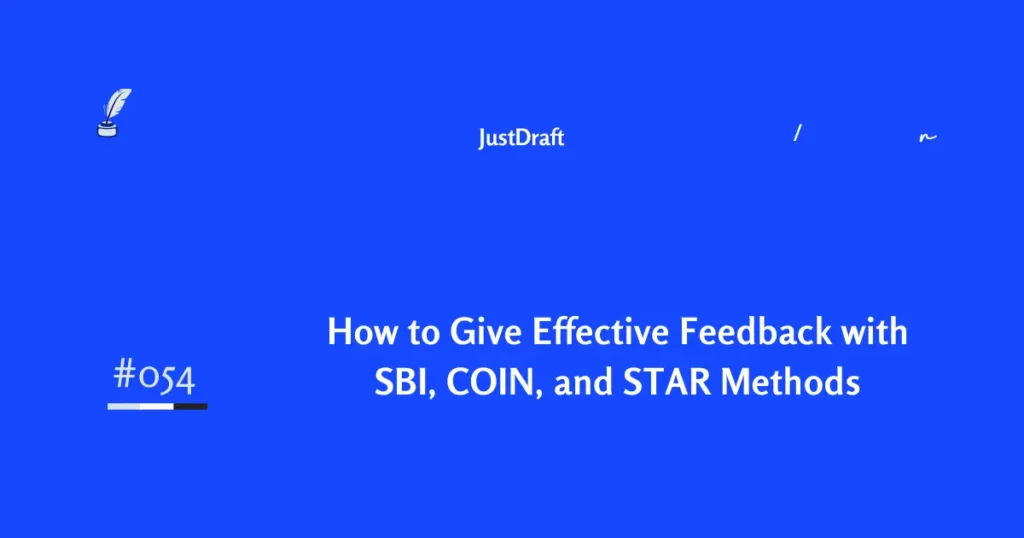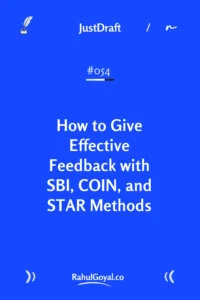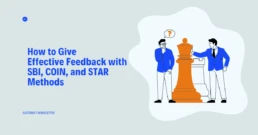The Manager’s Guide to SBI, COIN, and STAR Feedback Methods
I learned something surprising last year: most managers I know actually want to give better feedback. They just don’t know how.
Here’s the reality. Only 18-20% of managers provide feedback regularly. Not because they don’t care, but because they lack a clear system. They worry about saying the wrong thing, hurting feelings, or making things awkward.
But here’s what the research tells us: employees receiving meaningful feedback weekly are 80% more engaged. Companies with regular feedback cycles see 14.9% increases in engagement. And people who get frequent feedback perform 12.5% better than those who don’t.
The difference isn’t what you say. It’s how you structure it.
Three frameworks have changed how effective managers deliver feedback: SBI, COIN, and STAR. Each serves a different purpose. Understanding when to use which one will transform your leadership.
One Topic: 3 Feedback Frameworks (SBI vs. COIN vs. STAR Methods)
SBI: The Quick Feedback Framework
The Center for Creative Leadership created SBI to eliminate vague criticism. It’s the simplest framework, which is why it works so well for everyday coaching.
How it works:
Situation – Describe when and where it happened. Be specific. “In yesterday’s client meeting” works better than “recently.”
Behaviour – State what you observed. Facts only. No interpretations. Not “you seemed unprepared” but “you didn’t have the pricing sheet we discussed.”
Impact – Explain the consequence. “The client asked twice for pricing information we couldn’t provide, which extended the meeting by 20 minutes.”
I use SBI when I need to address something quickly.
Done in 30 seconds. No drama. Clear message.
The power of SBI is defensiveness reduction. When you stick to observable facts and measurable impacts, people can’t argue about your interpretation because you’re not making one.
Use SBI when:
- You need quick course correction
- The issue is straightforward
- You’re giving peer-to-peer feedback
- Time is limited
COIN: The Development Framework
Anna Carroll developed COIN for deeper conversations. It takes more time but builds stronger relationships and drives lasting change.
How it works:
Context/Connections – Start by establishing safety. Explain why you’re giving feedback. Acknowledge the person’s strengths. Create a comfortable space for dialogue.
Observations – Share what you noticed using neutral language. Multiple examples help show patterns.
Impact – Explain how the behaviour affected the team, project, or business results.
Next Steps – Here’s what separates COIN from other frameworks. You work together to define specific actions, timelines, and follow-up.
You don’t just identify the problem – you solve it together.
Use COIN when:
- The issue is complex or behavioural
- You’re in a one-on-one performance review
- Building psychological safety matters
- You need sustained behavioural change
STAR: The Evidence Framework
Development Dimensions International created STAR for evaluating past behaviour. It works because past performance predicts future capability better than anything else.
How it works:
Situation – What was happening? What challenges existed?
Task – What needed to be accomplished?
Action – What specific actions did you take? Why those choices?
Result – What was the outcome? What did you learn?
I use STAR constantly in hiring. Instead of asking “Are you good at handling conflict?” I ask “Tell me about a time you had to resolve a major disagreement between team members.”
But STAR isn’t just for interviews. I use it in project retrospectives: “Walk me through how you handled the vendor delay (Situation/Task). What actions did you take (Action)? How did it turn out, and what would you do differently (Result)?”
The conversation becomes about learning, not judgment.
Use STAR when:
- Interviewing candidates
- Running project retrospectives
- Evaluating promotion readiness
- Assessing problem-solving capability
What Makes Feedback Actually Work
The framework matters, but not as much as you think. Research shows three things drive feedback effectiveness:
- Frequency beats perfection. Employees receiving daily feedback are 3.6 times more likely to be motivated than those getting annual reviews. Weekly beats monthly. Monthly beats quarterly.
- Specificity beats volume. One concrete observation with clear impact outperforms ten vague statements.
- Follow-through beats eloquence. Adobe’s shift from annual reviews to continuous “Check-Ins” improved engagement by 30%. The framework stayed simple. They just did it consistently.
Common Mistakes to Avoid
- Vague observations. “You need better communication” tells people nothing. “In Monday’s meeting, you shared the project update without mentioning the two-week delay” gives them something to work with.
- Skipping the relationship. Jumping straight to criticism without establishing safety triggers defensiveness. Even 30 seconds of context helps.
- No follow-up. Feedback without next steps becomes conversation without change. Document what you agreed on. Schedule a check-in.
- Inconsistent delivery. Sporadic feedback feels like criticism. Regular feedback feels like development.
Which Framework When?
Here’s my decision tree:
- Need quick correction? → SBI. It’s fast, clear, and reduces defensiveness.
- Complex behavioural issue? → COIN. Take the time to build understanding and commitment.
- Evaluating past performance? → STAR. Let their actual behaviour tell the story.
The best leaders don’t stick to one framework. They use all three based on context.
I’ve tested all three frameworks for years. Here’s what I’ve learned:
Start with SBI. Practice it until it feels natural. You’ll use it more than the others combined. Add COIN for important conversations. The Next Steps component alone justifies the extra time. Keep STAR in your toolkit for evaluations. Nothing reveals capability like past behaviour.
Pick one. Practice it. Make it a habit.
Your team’s performance will show you it’s working.

Interested in travel, read last week’s LensLetter newsletter about Lightroom new release to enhance colour sliders.
Read last week’s JustDraft about Strategy Canvas Framework.
Two Quotes to Inspire
“Feedback is the breakfast of champions.” ~ Ken Blanchard
The best feedback isn’t the most eloquent, it’s the most consistent. Frequency transforms criticism into development.
One Passage From My Bookshelf
The biggest mistake people make when giving feedback is being too vague. They say things like “You need to be more professional” or “Your communication needs work,” but they don’t explain what specifically needs to change or why it matters. I learned this the hard way at Google. I had an employee who was brilliant but said “um” constantly during presentations. After one particularly important meeting, I told her she’d done a great job. I mentioned the “ums” briefly, trying to be nice about it. She thanked me and left. A colleague pulled me aside later and asked why I hadn’t been clearer. “That ‘um’ thing is holding her back,” he said. “If you don’t tell her directly, she’ll never fix it.” He was right. By trying to be kind, I’d actually been unkind—I’d withheld information she needed to grow.
The next day, I sat down with her again. This time, I was specific: “When you say ‘um’ every third word, it distracts from your excellent ideas. People focus on the delivery instead of the content. It’s a small thing, but it’s hurting your credibility with executives.” She looked shocked at first, then grateful. “Why didn’t you just say that yesterday?” she asked. Within two months, she’d nearly eliminated the habit. Her presentations became sharper, her confidence grew, and she eventually became one of our strongest leaders. All because I finally gave her feedback that was clear and actionable instead of vague and comfortable.
📚 From Radical Candor by Kim Scott (one of my favourite)


